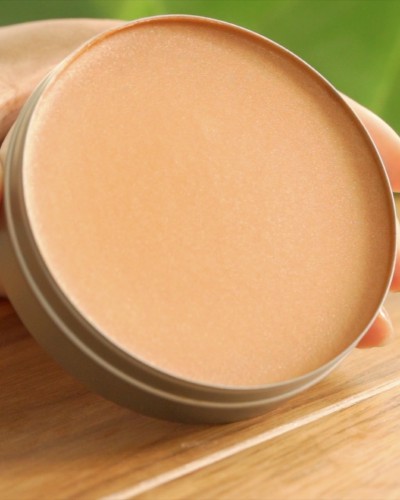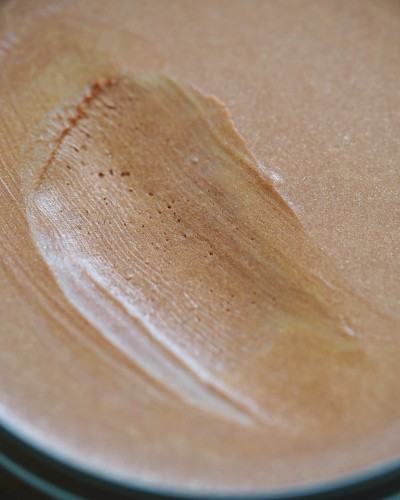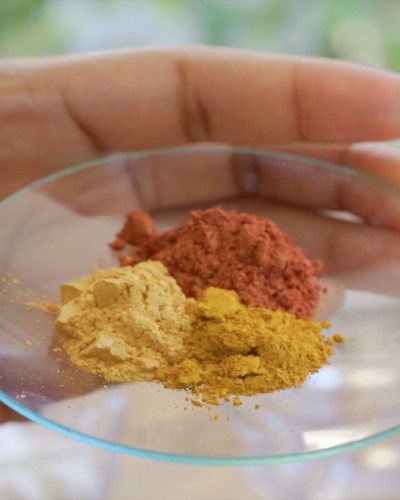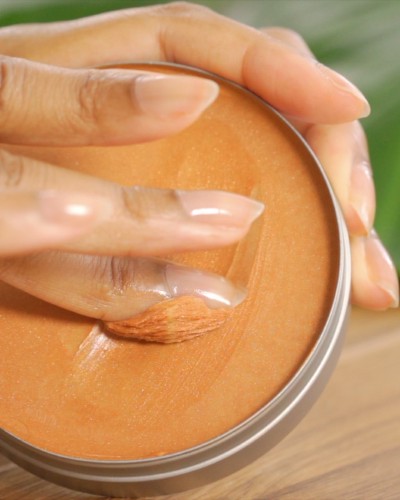Recipe
Phase A
- 52g Cupuaçu Butter
- 30g Kokum Butter
- 26g Coco-Caprylate/Capric
- 20g Grapeseed Oil
- 14g Stearic Acid
- 10g Cetearyl Alcohol
Phase B
- 30g Coco-Caprylate/Capric
- 10g Cornstarch
- 3g Red-Brown Iron Oxide
- 3g Bronze Mica Powder
- 2g Gold Mica Powder
- 1g Honey Pigment Powder
Cool Down
- 2g Optiphen (Preservative)
- 1g Vitamin E Oil (Antioxidant)
- 2g Essential or Fragrance Oils (Optional)
Method
- Measure out phase A ingredients: Cupuaçu Butter, Kokum Butter, Stearic Acid, Cetearyl Alcohol, Coco-Caprylate/Caprate and Grapeseed Oil
- Combine ingredients in a heat-proof container, and gently melt over a low heat using a bain-marie or double-boiler
- Once molten with no solids, take off the heat and allow to cool until thickened but still liquid
- Measure out phase B ingredients: Mica or Pigments, Cornstarch and Coco-Caprylate / Caprate. Whisk together until homogenous and completely smooth
- Combine phase B with phase A and blend thoroughly
- Pour into a tub-style container and leave to set either in the refrigerator or at room temperature for a minimum of 12 hours.
This recipe makes 100g and will last approximately 12 months. See the interactive formula to customise this recipe.
What is a body butter bronzer

Body butter bronzer: not sure if this term has been coined yet - but in case it’s not, you heard it here first!
This body butter bronzer combines ultra-moisturising body butter with a rich bronzing hue that evens out skin tone and deeply nourishes skin.
It can be used as an all-over body moisturiser, but this body butter bronzer is especially effective on exposed areas such as the legs and arms. As well as bums in the sun (that can always benefit from a little extra glow and smoothing)!
How to make a body butter base

How to make body bronzer
To make a body butter bronzer you will need to combine two separate elements, the body butter base (as discussed above) and the body bronzer. You can control the level of tint, sparkle and shade by using a combination of mica powders. However, for best results, I’d recommend using a variety of colourants:

- Mica powders are pearlescent with a natural sparkle that looks very pleasing on the skin, however, they typically don’t provide much colour payoff in moisturisers.
- Iron oxides are natural mineral pigments that have significant colour payoff, however they have a limited colour range.
- Pigment powders is a “catch all” phrase that typically refers to artificial or synthetic colourants, they can range in their intensity but will come in a variety of colours and shades.
How to use body butter bronzer
This body butter bronzer can be applied directly to your skin like a regular moisturiser. Once applied, let the butter gently absorb into your skin and try to avoid vigorous massaging. It is best used on exposed areas of skin, rather than under clothes as some of the bronzing pigment may transfer.
Body bronzers resemble their better known makeup counterparts but there are a few key differences to note.

- Sheer coverage: this isn’t spray tan in a tub! A body butter bronzer provides a subtle but effective tint to your skin that has an “airbrushing” effect. This helps skin appear healthier, evens out skin tone and provides a pleasing glow.
- Universal: makeup can and should be tailored to your unique complexion, but skincare is typically broader in its application. This formula is designed to complement a deep and broad range of tones, but I encourage you to experiment with different colours and pigments.
- Non-permanent: The selection of bronzing pigments I’ve used are designed to wash off easily so that they can be applied as and when necessary. It doesn’t require additional makeup removers and can be rinsed off using standard cleansing products in the shower.